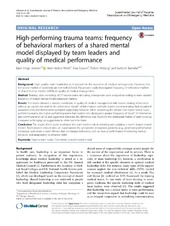| dc.contributor.author | Johnsen, Bjørn Helge | |
| dc.contributor.author | Westli, Heidi Kristina | |
| dc.contributor.author | Espevik, Roar | |
| dc.contributor.author | Wisborg, Torben | |
| dc.contributor.author | Brattebø, Guttorm | |
| dc.date.accessioned | 2018-03-01T12:59:02Z | |
| dc.date.available | 2018-03-01T12:59:02Z | |
| dc.date.issued | 2017-11-10 | |
| dc.Published | Johnsen BH, Westli HK, Espevik R, Wisborg TW, Brattebø G. High-performing trauma teams: frequency of behavioral markers of a shared mental model displayed by team leaders and quality of medical performance. Scandinavian Journal of Trauma, Resuscitation and Emergency Medicine. 2017;25:109 | eng |
| dc.identifier.issn | 1757-7241 | |
| dc.identifier.uri | https://hdl.handle.net/1956/17439 | |
| dc.description.abstract | Background: High quality team leadership is important for the outcome of medical emergencies. However, the behavioral marker of leadership are not well defined. The present study investigated frequency of behavioral markers of shared mental models (SMM) on quality of medical management. Method: Training video recordings of 27 trauma teams simulating emergencies were analyzed according to team -leader’s frequency of shared mental model behavioral markers. Results: The results showed a positive correlation of quality of medical management with leaders sharing information without an explicit demand for the information (“push” of information) and with leaders communicating their situational awareness (SA) and demonstrating implicit supporting behavior. When separating the sample into higher versus lower performing teams, the higher performing teams had leaders who displayed a greater frequency of “push” of information and communication of SA and supportive behavior. No difference was found for the behavioral marker of team initiative, measured as bringing up suggestions to other teammembers. Conclusion: The results of this study emphasize the team leader’s role in initiating and updating a team’s shared mental model. Team leaders should also set expectations for acceptable interaction patterns (e.g., promoting information exchange) and create a team climate that encourages behaviors, such as mutual performance monitoring, backup behavior, and adaptability to enhance SMM. | en_US |
| dc.language.iso | eng | eng |
| dc.publisher | BioMed Central | eng |
| dc.rights | Attribution CC BY | eng |
| dc.rights.uri | http://creativecommons.org/licenses/by/4.0 | eng |
| dc.subject | Trauma team leader | eng |
| dc.subject | Teamwork, shared mental model | eng |
| dc.title | High-performing trauma teams: frequency of behavioral markers of a shared mental model displayed by team leaders and quality of medical performance | eng |
| dc.type | Peer reviewed | |
| dc.type | Journal article | |
| dc.date.updated | 2018-01-03T18:05:39Z | |
| dc.description.version | publishedVersion | |
| dc.rights.holder | Copyright 2017 The Author(s) | eng |
| dc.identifier.doi | https://doi.org/10.1186/s13049-017-0452-3 | |
| dc.identifier.cristin | 1516992 | |
| dc.source.journal | Scandinavian Journal of Trauma, Resuscitation and Emergency Medicine | |

